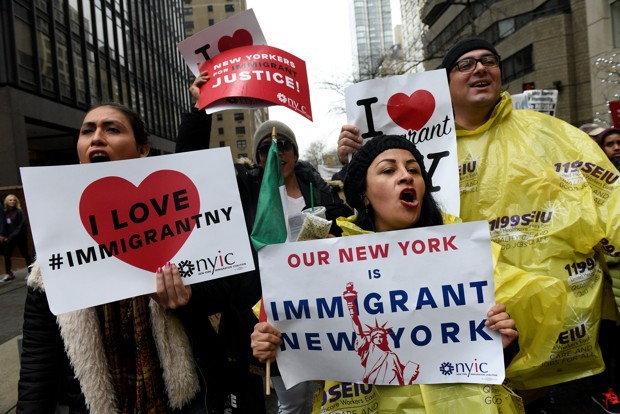The federal funds under threat could amount to more than 20 percent of a city budget, or less than 1 percent. Either way, cities could well end up hurting.

Earlier this month, Governor Jerry Brown of California captured the admiration of many a Trump adversary during a speech on climate change at the American Geophysical Union Conference in San Francisco. “If Trump turns off the satellites [collecting climate data], California will launch its own damn satellites!” he exclaimed to a cheering room.
This is, indeed, what the resistance sounds like. Local and state governments all over the country are gearing up for a bitter fight with the incoming administration over several points of policy, including climate change and immigration enforcement—the latter of which is especially pressing for cities. Trump has promised to revoke federal funding for sanctuary cities within his first 100 days. A long list of major cities have since gone on record to say they won’t change their policies despite those threats—but if Trump could succeed in keeping every federal grant from reaching their coffers, it could constitute a devastating financial blow to metros that refuse to cooperate with federal immigration officials.
Luckily for the cities vested in these policies, that’s a key conjunction: if. Various legal obstacles stand in the Trump administration’s way. They could prove onerous enough to nix his attempts altogether, or water them down so much they become nothing more than wrist-slaps for the cities in question. CityLab consulted experts in constitutional law (and this post from the Center for Tax and Budget Accountability) to lay out exactly what hoops the administration might have to jump through in its quest to force cities into compliance with federal immigration enforcement programs, and how much money could eventually be at risk.
From our partners:
A statutory challenge
According to Ilya Somin, a professor at George Mason University of Law who has written previously about the subject, the first obstacle Trump faces doesn’t even have to do with constitutional law; it’s a question of simple statutes. For decades, Supreme Court precedent has maintained that any condition on a federal grant must be expressly written into the law in a “clear and unambiguous” fashion. Somin says there are likely very few federal grants expressly conditioned on compliance with deportation efforts—in fact, he can’t think of any at all. So Trump wouldn’t be able to simply withhold all federal grants from particular cities on his first day in office. He would need help from Congress in the form of entirely new grants, all written with the stipulation that cities must comply with deportation efforts in order to receive funds. That could take much longer to accomplish than Trump has implied, although with Republican majorities in both houses, it’s certainly not out of the question.
Is the funding ‘germane’?
But here Trump would encounter yet another obstacle. Say the administration got Congress to pass a law that ties federal grants to local compliance with deportation efforts. The next question becomes, ‘Are all of those grants germane?’ That is, are the conditions for withholding relevant to what the funds are actually used for?
States and localities across the country receive federal grants for everything from education to housing to infrastructure to law enforcement. The narrowest interpretation of the ‘germane’ qualification means that only grants related to law enforcement or immigration would be at risk, since those are the only ones directly relevant to immigration enforcement. That would likely represent a manageable loss for most large cities—just a small part of their overall operating budgets. But according to William Baude, a professor of law at the University of Chicago who spoke with Daniel Hertz at the CBTA about this issue, courts could also conceivably take a much wider view, and decide that all grants that benefit undocumented immigrants are fair game. That would include basically all grants, because city services and programs—from infrastructure to education to parks—all benefit undocumented people in one way or another. Losing all those grants would be a much bigger monetary hit —nearly 14 percent of Chicago’s total operating budget, according to Hertz.
Are the conditions coercive?
According to Supreme Court precedent from last year’s Affordable Care Act ruling, the federal government cannot place conditions on funding so severe that they constitute a “gun to the head” of the locality. In the Obamacare ruling, that determination came from the administration’s attempt to withhold Medicaid funding from those states that refused to expand the program. Withholding all Medicaid funding (which would substantially affect the state’s budget and healthcare access for millions of people) was deemed to be “unconstitutionally coercive.”
If the Trump administration managed to take away all federal grants from sanctuary cities, this move could also be deemed too coercive. But according to Somin, ”what exactly qualifies as a ‘gun to the head’ remains unclear.” In the case of big cities, all federal funding might add up to only around five percent of the total budget, which is presumably less financial pressure than the ACA was exerting on states—but that doesn’t mean that the loss would be manageable.
How much could this hurt a city?
It’s hard to say whether Trump’s policies could hit a city hard enough to make sanctuary city policies untenable there. That depends on whether the city could fill some of the gaps created by the loss in funding with its own revenues, and how much political will it has to continue its refusal to participate in deportation efforts. It also depends on how much money Trump could ultimately take away.
The chart below shows what it would look like for five different major sanctuary cities to lose all of their federal grant funding, as a percentage of their total operating budget.

Some of the above percentages are huge chunks of the city budget, particularly in Washington, D.C., and Chicago. In D.C., federal grants make up more than 20 percent of the total budget, which would likely make withheld funds difficult for the city to absorb—and would probably be unconstitutional under Supreme Court precedent. But even in cities like L.A. and San Francisco, where the effect looks comparatively small, losing this money could still be damaging.
“L.A. has an $8 billion budget, but some of these [federal grants] go to our highest-need areas,” says Connie Llanos, the press secretary for Mayor Eric Garcetti. “It’s not really about something being about X percentage of the total budget. If you remove one of these pots of funding, there’s nowhere for the city to backfill it from because it’s not something we fund.”
Given these huge numbers and the logistical complications, it seems unlikely (though certainly not impossible) that Trump would be able to stop every flow of federal funds. So with help from Philip Wolgin at the Center for American Progress, CityLab outlined another tactic Trump could take: Below, we’ve charted five specific federal grants going to the same cities we looked at above. These grants were chosen, Wolgin explains, because congressional Republicans have already targeted them in legislative attempts to defund sanctuary cities in 2015 and 2016. As such, they seem like a logical place for the new administration to begin.
These grants go toward funding for things like law enforcement (JAG and COPS), reimbursement for incarceration of undocumented immigrants (SCAAP), and economic development and anti-poverty initiatives (the Economic Development and Community Development Block Grants).
All of the above grants constitute less than 1 percent of each city’s total budget. As Wolgin told CityLab via email, these funding streams shouldn’t be taken as a complete list of those that could be at risk—just a starting place, given that they’ve been part of the debate already. “I also do not mean to concede in any way that the administration or Congress legally could cut any of these funding streams—there may be constraints on what conditions can be placed on various funding streams (which is a big open question),” Wolgin adds.
Most of the cities we contacted said they couldn’t speculate about what losing these grants might do to the budget. But in L.A., Llanos mentioned that losing several grants—in particular, community development block grants, which help create jobs in high-need areas—would likely disproportionately affect low-income residents.
The city officials I spoke with also usually reaffirmed their commitment to maintaining their policies despite the threat of funding cuts. “[The Mayor] will stand in opposition to policies that threaten our values,” says Susana Castillo, deputy press secretary for Mayor Muriel Bowser in D.C., in an email statement.
It remains to be seen how firmly Bowser (or any other mayor) will truly be able to stand her ground—but given the myriad legal obstacles in Trump’s path, the administration’s promises to cut funding don’t look quite so surefire either.
This feature originally appeared in Citylab.
















